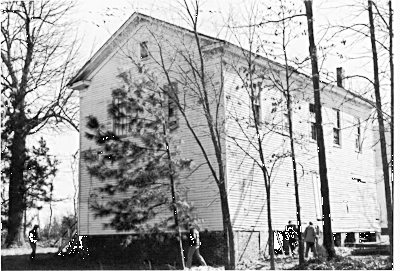Center for Historic
Preservation


|
Mission Statement
|
|
The Center for Historic Preservation exists to improve the quality
of life and future
economic development opportunities for Tennessee through
identification, research,
preservation, protection, interpretation and promotion of our
historic environment, which
includes sites, buildings, districts, objects, documents,
structures, oral history and folk
traditions. Through its research publications, projects, programs,
activities and specialized
library, equipment and facilities, the center responds to the
requests, needs and
concerns of communities, individuals, agencies and organizations,
both governmental and
not-for-profit, working toward historic preservation
goals. |
Goals and Objectives
|
|
- Initiate and support policies and programs which promote an
enhanced quality of life and economic opportunities which are
aligned with and based on the sensitive man agement and
conservation of historical resources.
- Assume a leadership role in public policy formation and
implementation on matters relating to historic preservation issues.
- Support the academic programs of MTSU through teaching and
training students in specific historic preservation course work and
center projects.
|
Introduction
|
| The Center for Historic Preservation
commits its resources to the identification, protec-
tion, conservation, interpretation and continued use of our
historic resources. The center
participates in partnerships in the state and in the broader
Mid-South among those who
can contribute to successful preservation in rural and urban
communities. In this way,
economic development and pride of place is supported through the
enhancement, protec-
tion and promotion of heritage resources. |
Publications
|
| Tennessee Agriculture: A Century Farms
Perspective documents farms, in 94 of the
state's 95 counties, that have been owned and operated by the same
family for at least
100 years. This publication was published in 1986 in cooperation
with the Tennessee
Department of Agriculture. The Best of Both Worlds: The Challenge
of Growth Enhancement
in the Mid-South was published in 1988 with grant support from the
National Trust
for Historic Preservation. Does the Past Hold a Future for You? is
a guide to career
opportunities in historic preservation and related professions.
This was published in 1990
in cooperation with the National Center for the Study of History.
Painting Historic
Buildings: Materials and Techniques, An Annotated Bibliography was
published by the
National Park Service in 1993. Hearthstones, an architectural
history of Rutherford
County, was published in 1994 as a cooperative effort with the
Oaklands Association. |
Major Programs
|
| The services of the center generally
fall within six programs or initiatives.
Town and Country Preservation focuses on the unique
heritage, resources and chal-
lenges of rural areas and small towns. This initiative includes
National Register survey
and nominations for districts and individual properties, as well as
the ongoing, statewide
Century Farms program.
Heritage Tourism is concerned with the sensitive management,
protection, interpretation and promotion of Tennessee's cultural,
historic and natural resources and the economic benefits available
to communities and organizations through tourism. |
|  |
HISTORY IN THE REMAKING -
A team of
students and staff from the Center for Historic Preservation
examines the Stanton Masonic Lodge and Old School (ca. 1871,
Haywood County) as part of a 1986 historic structures report which
was used as a guide in the now-completed restoration project.
|
| Heritage Education supports the
work of the Basic Schools Program in Tennessee and
the national Goals 2000 education reform efforts by promoting the
use of community
heritage resources in K-12 classrooms and through teacher training.
The Building Technology and Architectural Conservation
Initiative provides technical
services, previously unavailable in Tennessee, for persons involved
in architectural
restoration.
The Information Resource Management Initiative links the
center and its staff to the
outside world though the information superhighway.
The Historic Sites and Museums Initiative responds to
increasing requests for technical
assistance from small and rural Tennessee communities interested in
having more permanent
heritage programs.
|
Major Accomplishments
|
| The center has provided assistance,
services and programs which have positively affected
the historic resources of every Tennessee county. For example, the
Century Farms program
now includes documentation from all 95 counties and the traveling
exhibit which
toured the state in 1988-89 visited 20 towns. National Register
Districts have been
prepared for many communities, including Covington, Dyersburg,
Cumberland Gap,
Sparta and Lynchburg. Historic Structures Reports have been
developed as research and
recommendation guides for over 40 restoration projects, including
Clover Bottom Mansion
(Davidson County), Stanton Lodge and School (Haywood County),
Hamilton Place
(Maury County), the T. S. Stribling House (Wayne County) and the
Collier-Crichlow
House (Rutherford County). Education programs have been provided
for Main Street
Columbia, Pulaski and Murfreesboro, the Carmichael Inn in Loudon
County, Manskers's
Station in Goodlettsville and Liberty in Dekalb County.
Conservation reports for the
Tennessee Supreme Court Building, Oaklands Mansion in Murfreesboro
and many
historic residences have assisted in restoration planning. The
center has also cooperated
with Shiloh and Stones River National Battlefields in ongoing
interpretive and conservation
efforts. |
Conclusion
|
| In the next five years, the center
will continue its varied work to link heritage and economic
development in its six initiatives. Planning is proceeding on a
second publication
on Tennessee's Century Farms. The Heritage Education Initiative
will involve more
Tennessee communities and alliances with local historic sites. The
Heritage Tourism
Initiative proposal for a National Heritage Area on the Civil War
in Tennessee will require
collaborative partnerships in 55 counties. In Murfreesboro, an
effort is underway to
create a heritage tourism gateway linking local historic and
cultural sites. A "Tennessee
Heritage at Risk" report will assess endangered and/or overlooked
resources including
African-American sites. A conference on the Rosenwald Rural School
Program is scheduled.
The center will produce, in joint partnership with the Tennessee
Historical Society,
an encyclopedia of Tennessee. Finally, a national architectural
artifacts collection and
inventory, developed in association with the National Park Service,
should lead to the
development of a standard nomenclature
|


|

